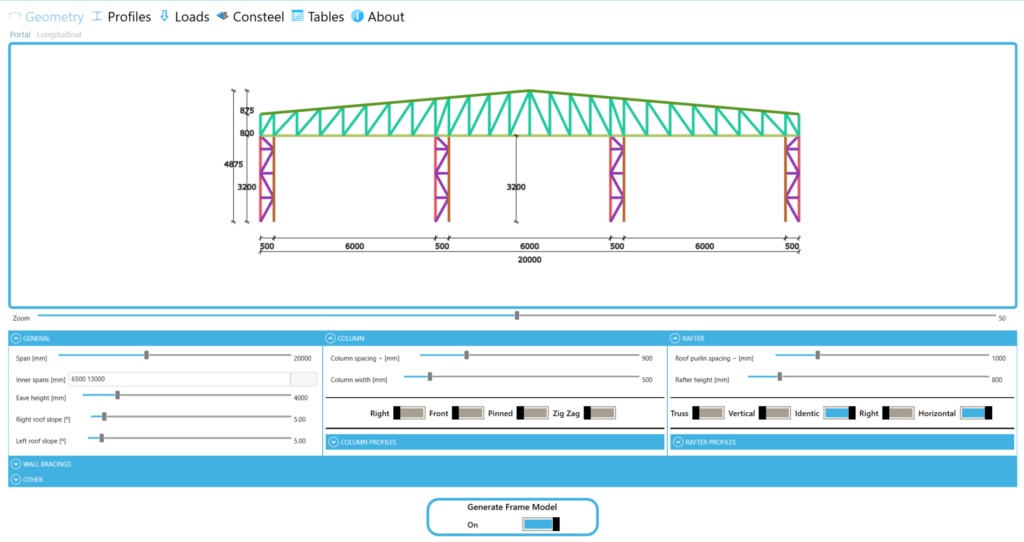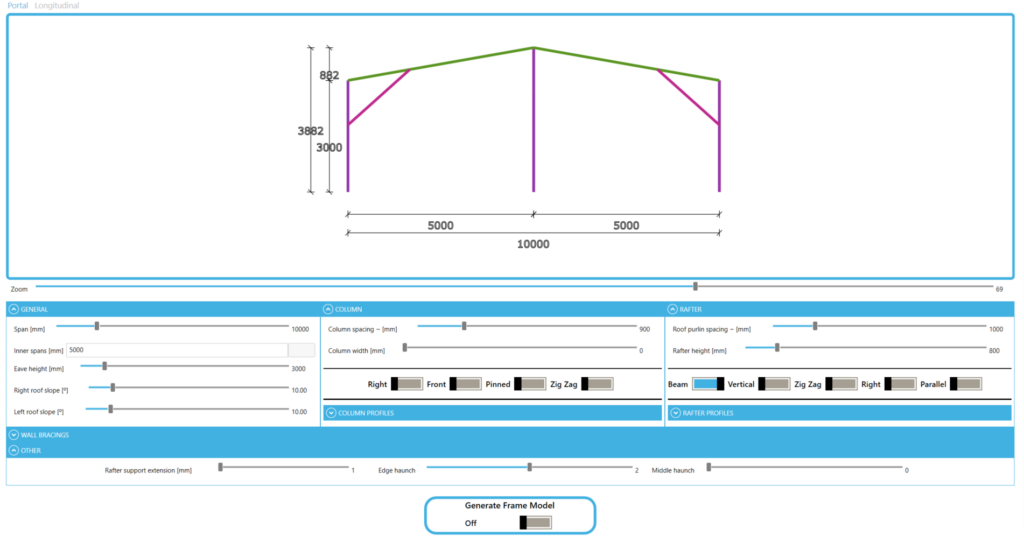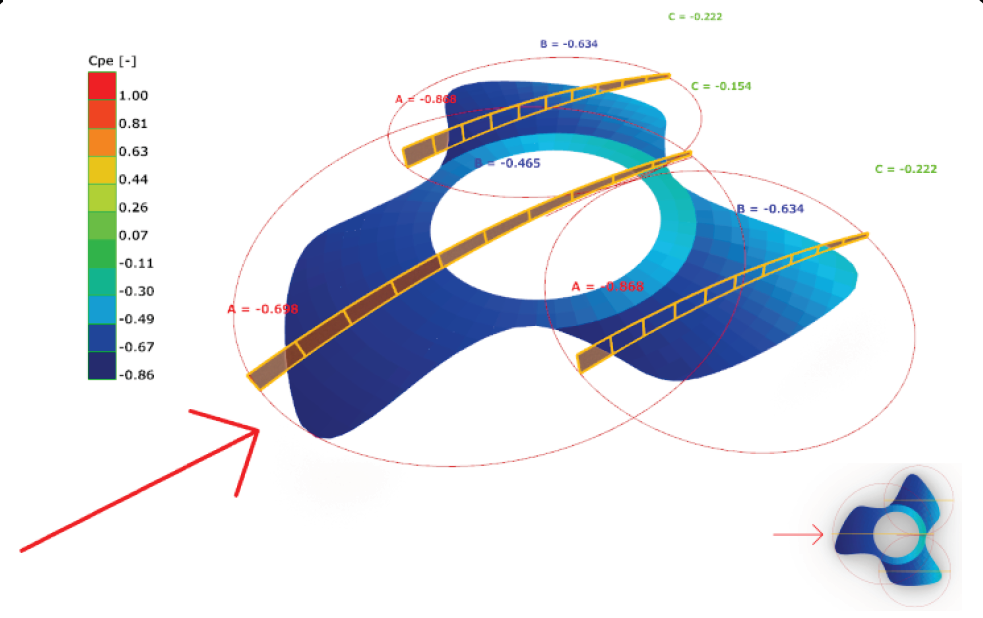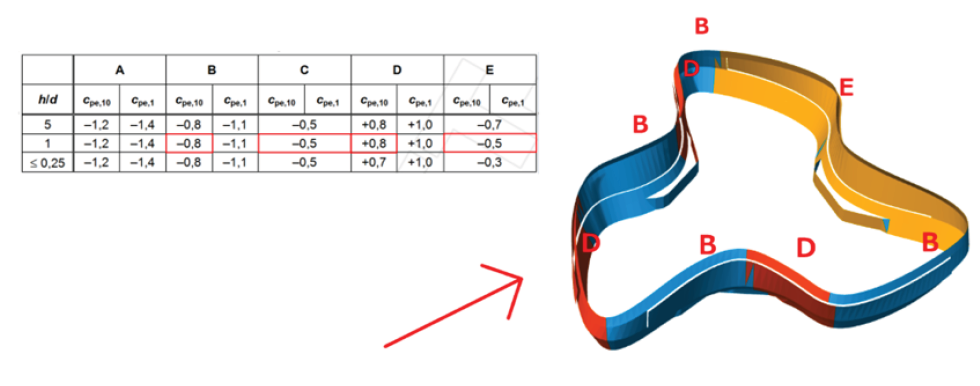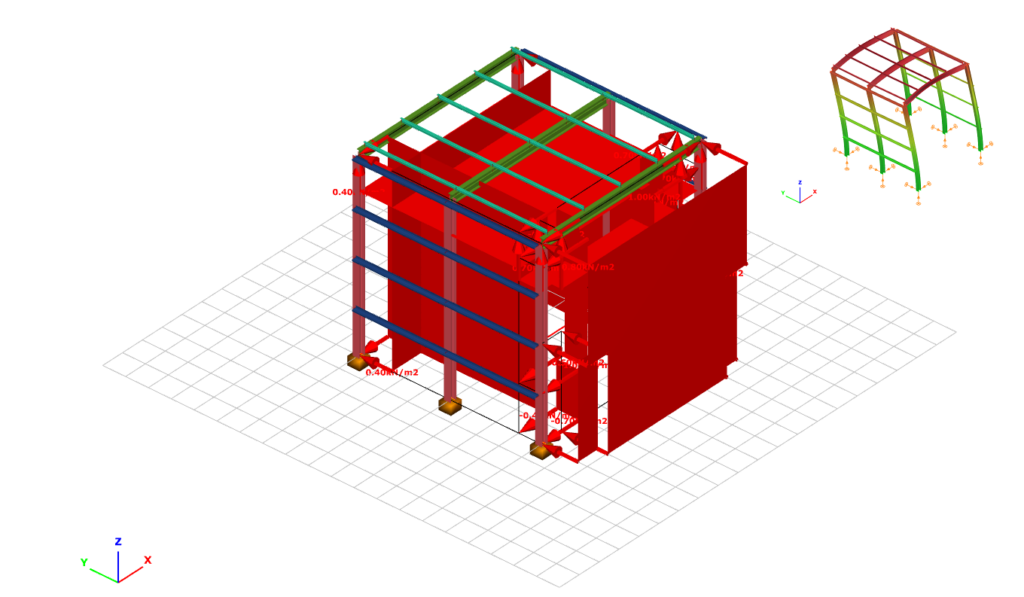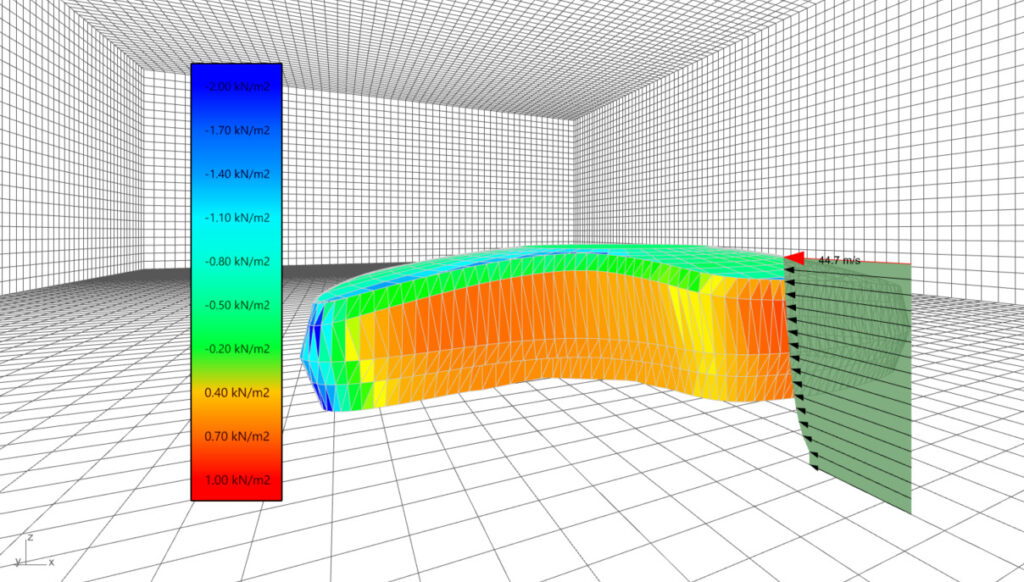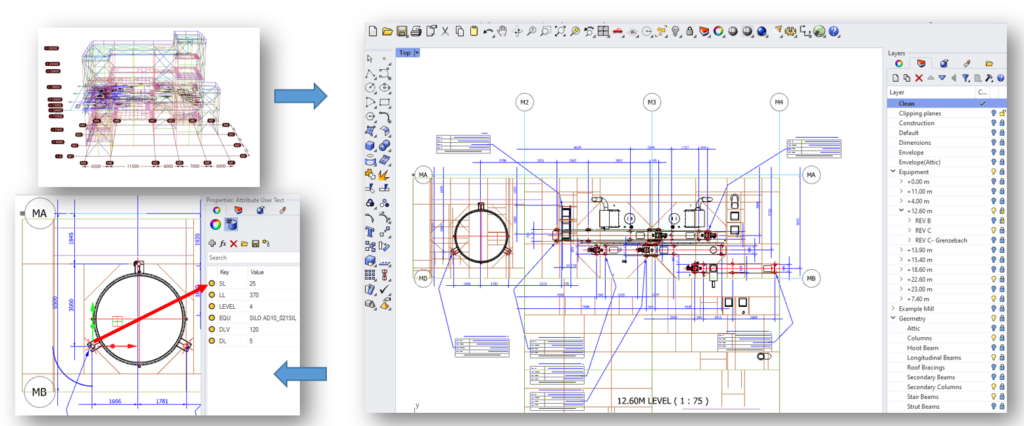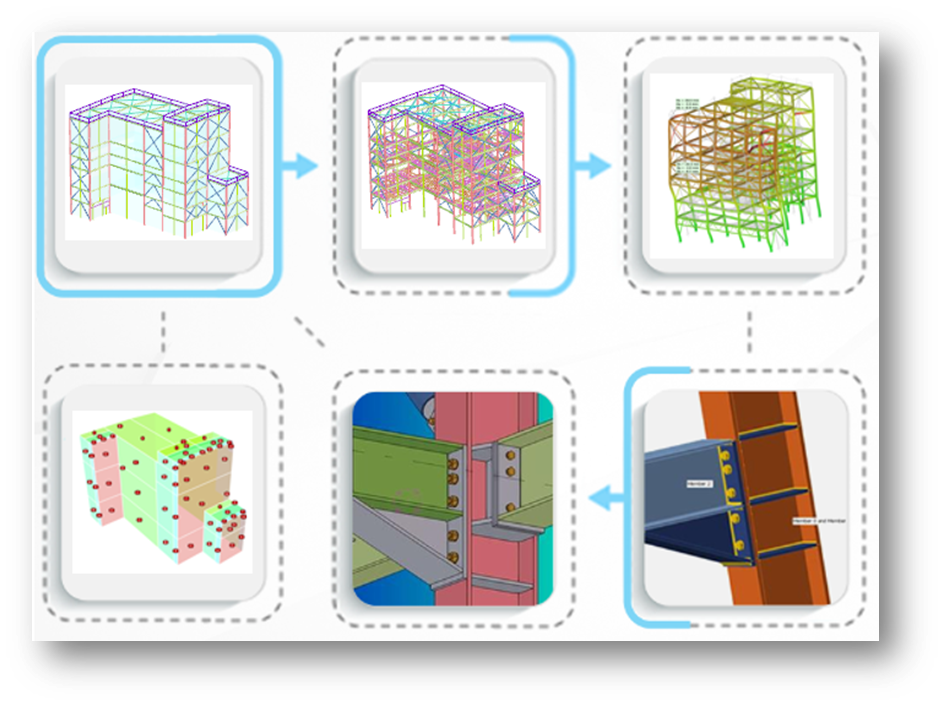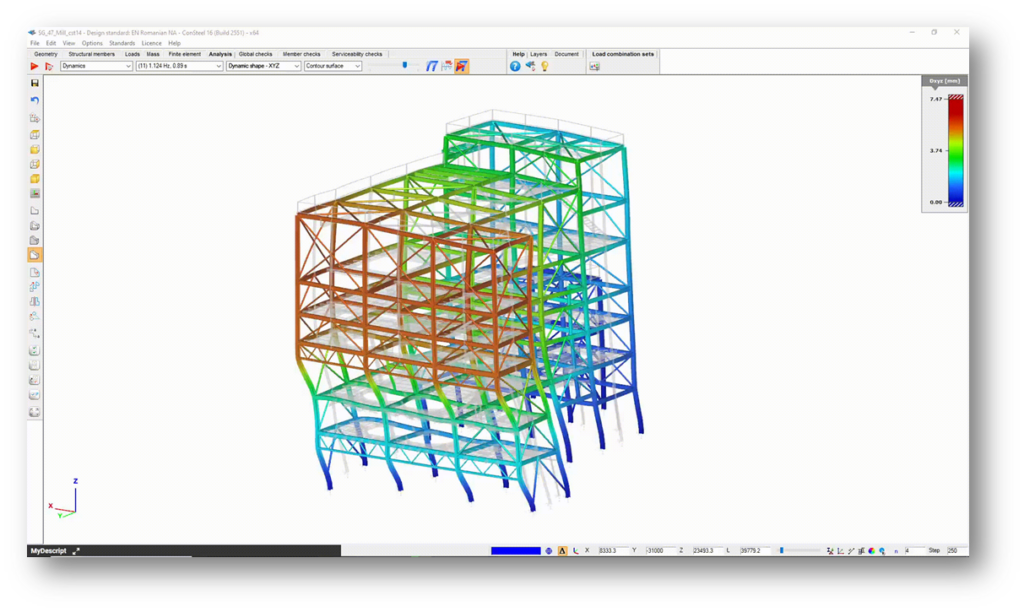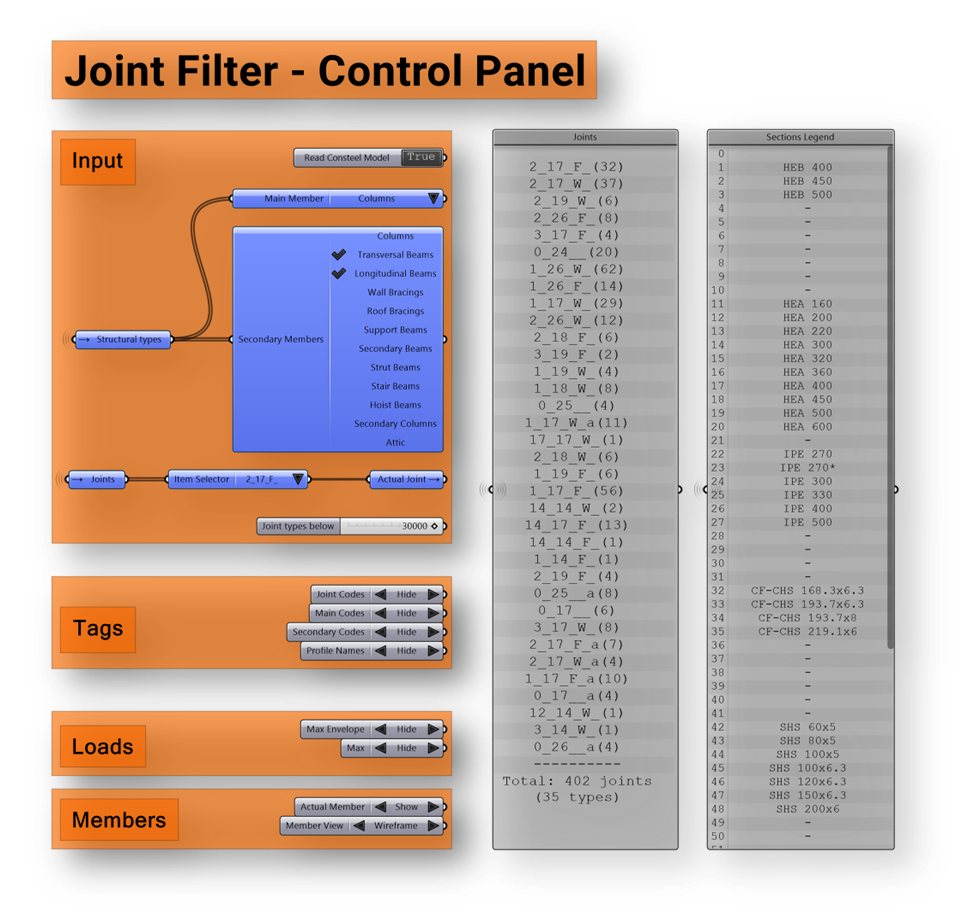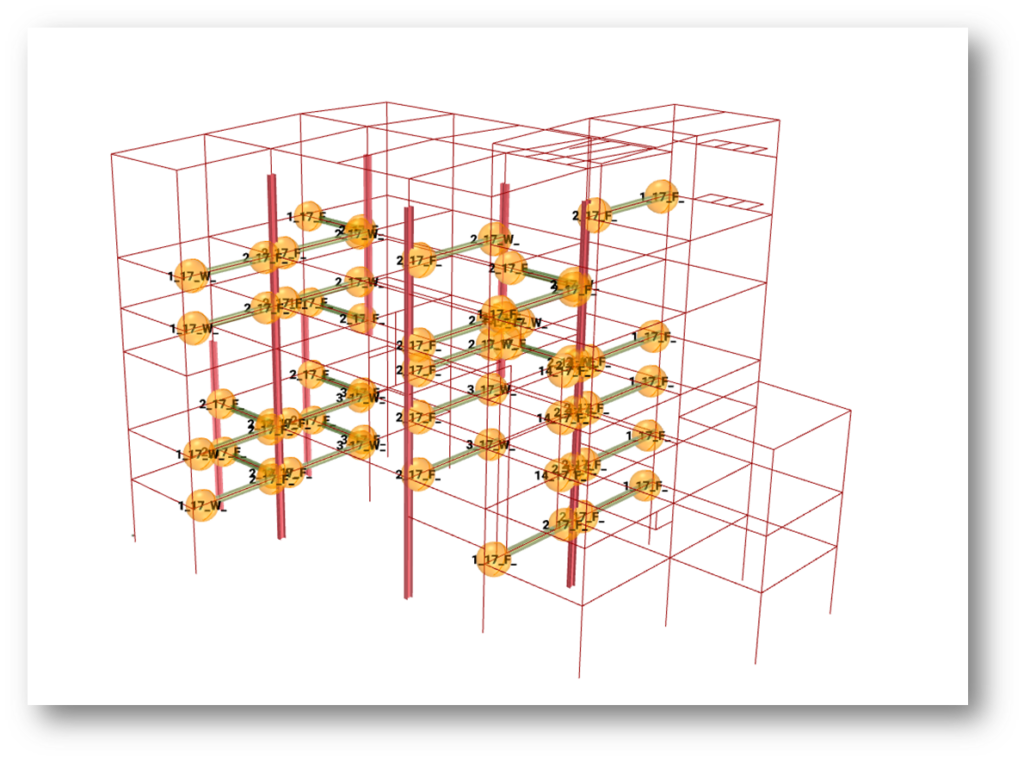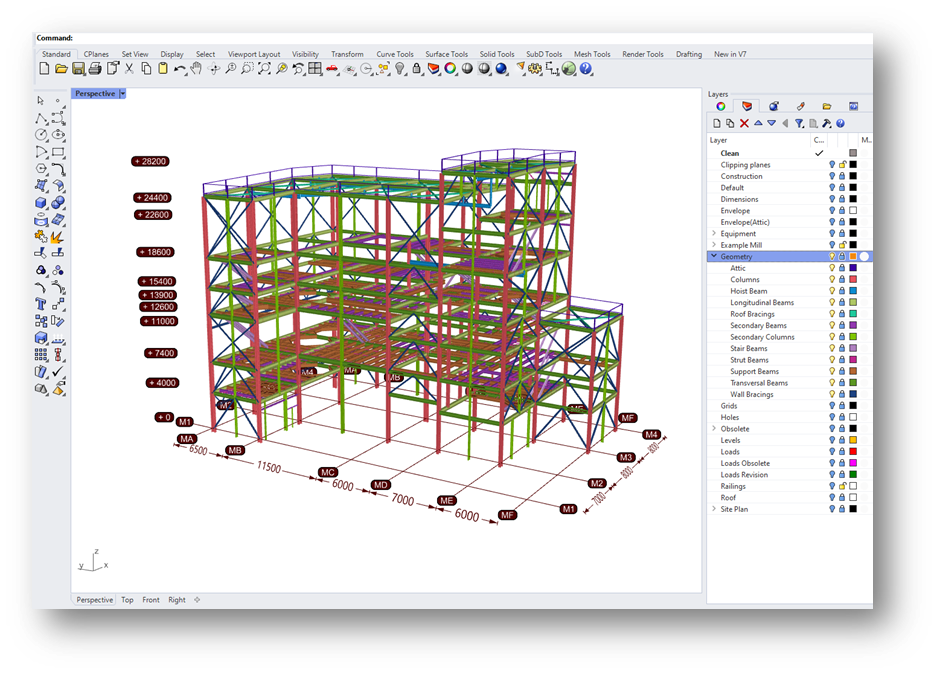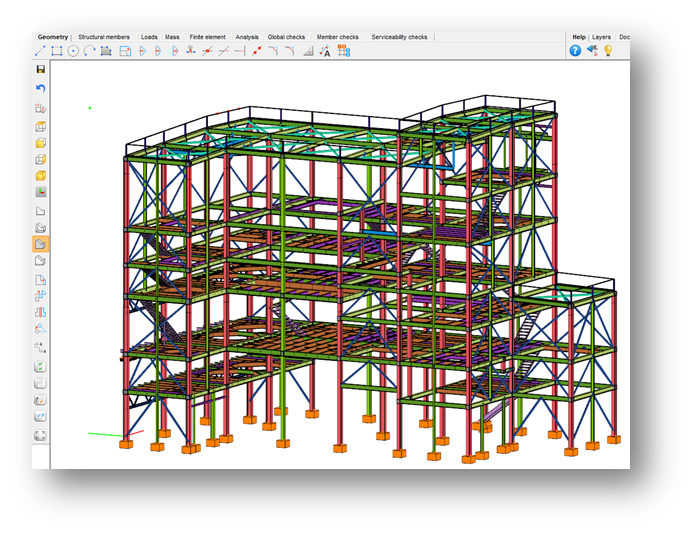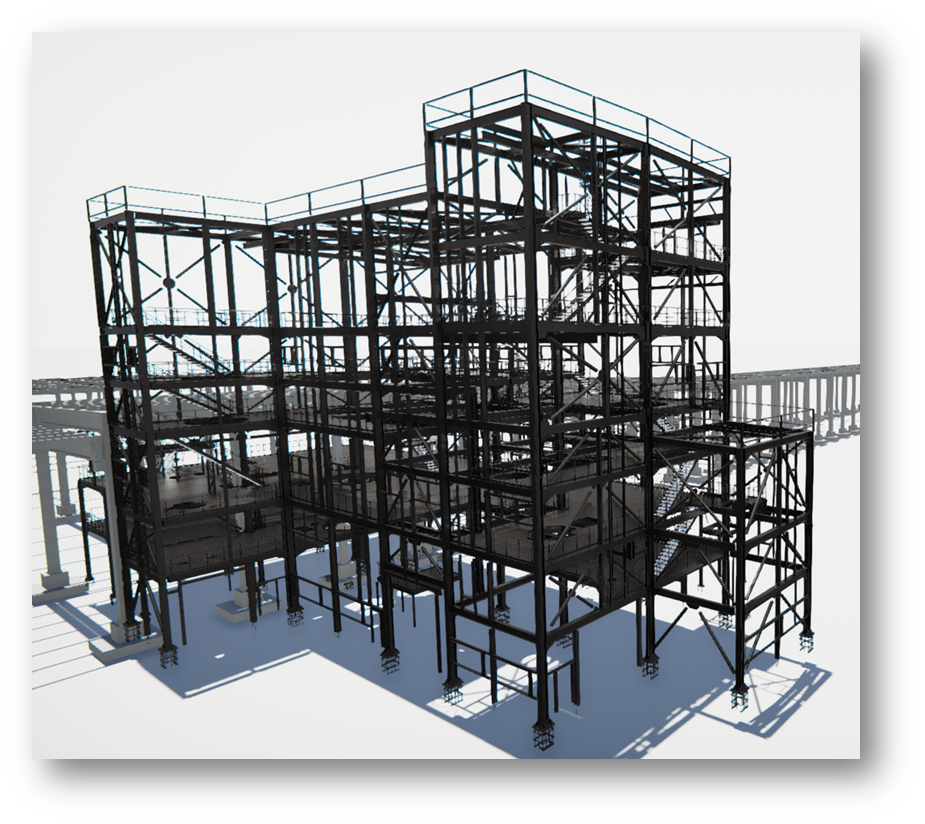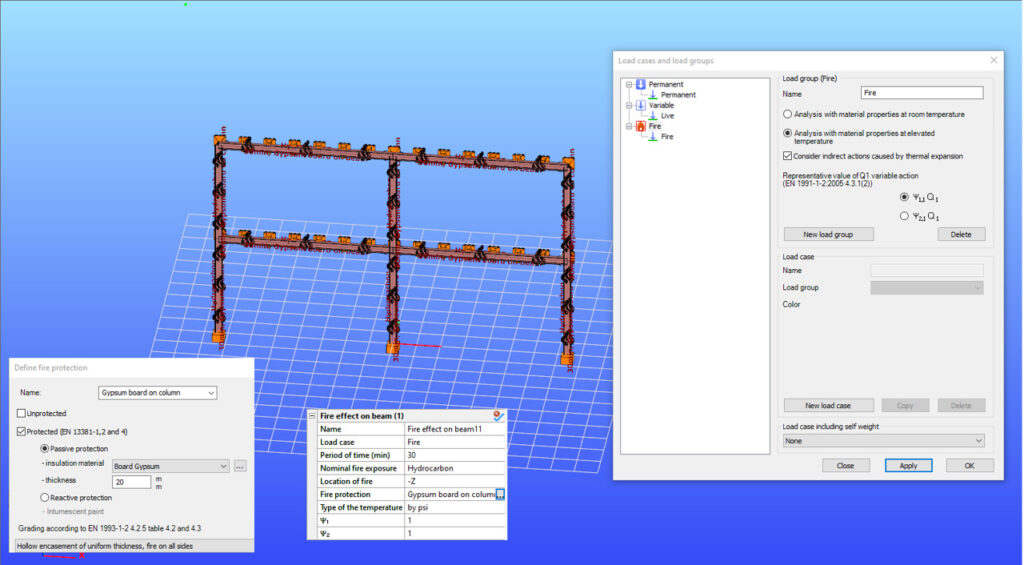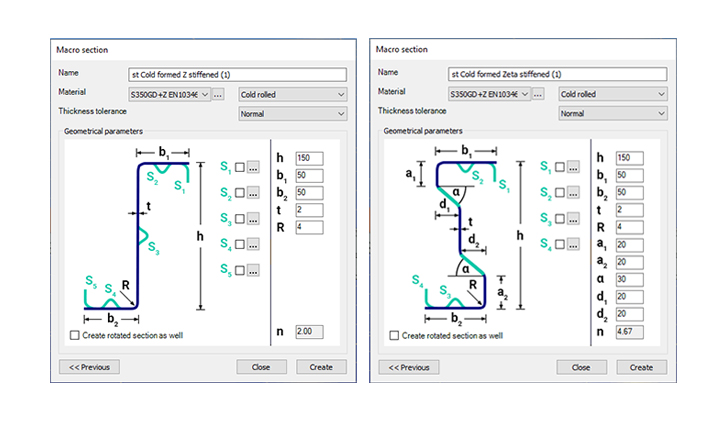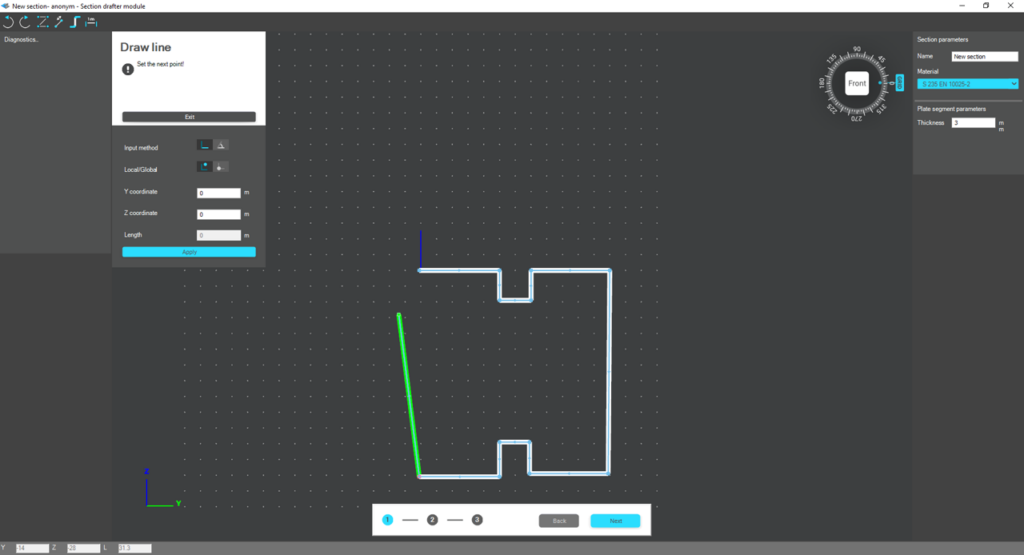Are you looking to elevate your structural design process? Do you want to automate repetitive tasks and explore more creative solutions? Our new Introduction to Parametric Design training is designed to bridge the gap between traditional structural engineering and cutting-edge parametric design methodologies.
This training is tailored for both
- Consteel users who have heard about parametric design and Grasshopper but haven’t had the opportunity to dive in, and
- Grasshopper users looking to apply their skills specifically to structural engineering with Consteel.
Expand your design possibilities
Our training uniquely combines the strengths of multiple platforms:
- Rhino with Grasshopper: The industry-standard environment for parametric modeling
- Pangolin: Our custom plugin that bridges Grasshopper with structural engineering workflows
- Consteel’s Descript: Our powerful in-built scripting environment
By understanding how these tools work together, you’ll develop a comprehensive toolkit that spans from conceptual design through detailed structural analysis.
The training provides a balanced approach to both environments, ensuring you can leverage the full potential of parametric design in your work:
1. Foundation skills
- Navigate Rhino and Grasshopper’s interface specifically for parametric design
- Master Consteel’s Descript environment for streamlined scripting
2. Cross-platform workflows
- Connect Grasshopper and Consteel through live scripting
- Build a simple beam example to understand the fundamentals
3. Real-world applications
- Create a parametric transmission tower model—from wireframe geometry to full analysis
- Design and investigate a hall structure with a canopy
- Interpret Consteel results within Grasshopper for iterative refinement
4. Optimization techniques
- Compare optimization approaches in both Grasshopper and Descript
- Focus on section optimization for a simple truss design
- Learn practical methods for evaluating multiple design solutions
Why parametric design matters?
In today’s competitive environment, parametric design has become an essential approach for forward-thinking engineers and designers. The efficiency gained through automating repetitive tasks allows professionals to dedicate more time to creative problem-solving and innovative thinking.
Parametric methodologies enable teams to quickly evaluate multiple design alternatives, leading to more thorough exploration of possibilities that might otherwise remain undiscovered. Engineers can fine-tune their designs with unprecedented precision, optimizing for crucial factors like performance, cost-effectiveness, and sustainability benchmarks.
Perhaps most importantly, parametric design fosters improved collaboration by creating standardized workflows that enhance communication between architects and engineers, breaking down traditional silos that have historically limited interdisciplinary innovation. As structural engineering continues to evolve, these parametric approaches increasingly represent not just a competitive advantage but a fundamental shift in how we conceptualize and execute complex structural projects.
Ready to transform your design process?
This training represents an investment in skills that are becoming increasingly essential in modern structural engineering. Whether you’re looking to stay competitive in the industry or simply curious about expanding your capabilities, our Introduction to Parametric Design training provides the perfect foundation.
More about the trainingWe are excited to unveil the first version of our long-term development project: the FALCON plugin, a comprehensive wind load generator tool based on fluid-dynamics simulation. Let us know if you would like to participate in the testing.
We are about to release the first version of our wind load generator plugin
FALCON (Fluid-dynamics Aided Loads in Consteel) is a universal load-generation tool supported by fluid dynamics simulation, with the first integration to be released with the Consteel 18 release, in late Autumn 2024. It aims to provide structural engineers with the ability to determine realistic wind loads for any building type, comparable to standards.
Instead of creating a comprehensive simulation tool, that requires considerable expertise in fluid dynamics, we focus on the interpretation of the results. This approach builds on the logic of engineers‘ wind load assessment and gives users more flexibility to apply their insights.
Free beta version
The FALCON plugin will be introduced in Consteel 18 in a free beta version, available for preliminary testing and use. Following a fine-tuning phase in collaboration with our dedicated users, the final version will be released next year.
Registration is required to use the beta version of FALCON.
We will involve you in testing
In pursuing our mission, to comprehensively reform the way structural design is done, we are committed to researching and implementing state-of-the-art methods of structural design, and always keeping an eye on the latest technological changes, while also placing great emphasis on fostering cooperation and the spirit of community.
That’s why we are launching an exciting new initiative that we want you to be part of.
We want to involve our users in testing and calibrating the beta version of the FALCON wind load generation plugin. This way, based on feedback and joint reflection, we can develop the final version, a tool that best suits your needs.
FALCON beta community testing/calibration
It’s worth taking part because:
- you have exclusive access to the beta version of the FALCON wind load generation plugin
- you can use FALCON for free during the testing period
- you can be the first to try out the new features
- you can be a member of a supportive professional community
- sharing your experiences and opinions is appreciated
- you will be part of the development of a new wind simulation tool
- you get discounts for active participation
The FALCON beta community testing process
- Registration for the FALCON beta community testing: from September 2024 – April 2025 onwards
- FALCON beta release: end of the Autumn 2024
- FALCON plugin demonstration webinar
- Online workshop sessions
- Roundtable discussion (last workshop session)
- FALCON training
- FALCON plugin release: Spring 2025
Discounts for cooperation
We also show our gratitude to test participants by offering them various discounts, depending on the intensity of their cooperation. You will be able to buy the FALCON wind load generator plugin with up to 50% discount and even participate in the related training courses for free.
Shape the future with us! By participating you can directly influence development. Share your opinions and suggestions with us, so we can shape the direction of Consteel’s development together!
Interested in this opportunity? If so, fill in our short application form. We will then contact you shortly with further details. There is no commitment at this stage. Don’t miss this opportunity, let’s make Consteel even better together!
JoinGot a question? Feel free to contact us at info@consteelsoftware.com. For further information about participating, see our Conditions of participation information.

Since we entered in the world of parametric design with our Grasshopper plugin Pangolin, we have observed numerous remarkable projects characterized by significant geometrical and structural intricacy. However, these projects are so unique that it is hard to effectively transfer the experiences and standardize certain parts of the parametric design workflow, particularly within design firms employing numerous structural engineers. But what happens in the case of modular or pre-engineered buildings? One of our customers has the answer. Let us delve into the details and then watch the accompanying video for a practical demonstration.

When one begins to implement parametric methodologies in design, it is essential to start with the end in mind, formulating a well-defined goal to minimize the number of parameters required. Mexi Steel, a designer and manufacturer of cold-formed steel buildings, had such a clear objective: a tool that could, based on their expertise, internal capabilities, and solutions, swiftly generate a mechanically accurate Consteel model according to a set of variables, with all potential loads evaluated in various cases and combinations. This tool should assist structural engineers in decision-making by providing precise material lists (beams and bolts) derived from the Consteel model results during the concept design phase, thus facilitating more accurate quotations. In collaboration with our local distributor, REFLEX Software, the first version of this tool was developed within approximately two months in 2022. The tool delineates the primary steps of the design workflow and offers a sequential user interface with multiple tabs.
First, the geometry at the portal level must be defined in 2D by specifying a few global or general dimensions of the building and providing information regarding the columns and rafters. Once the portal frame is generated and the loads are quickly evaluated, it becomes possible to examine the standalone portal and predesign the cross sections.
The next step involves defining the parameters in the perpendicular or longitudinal direction. When the portal frame is a truss, it consists of several members, and all translations of the main axis as well as rotations of the cross sections are considered using link elements in Consteel.
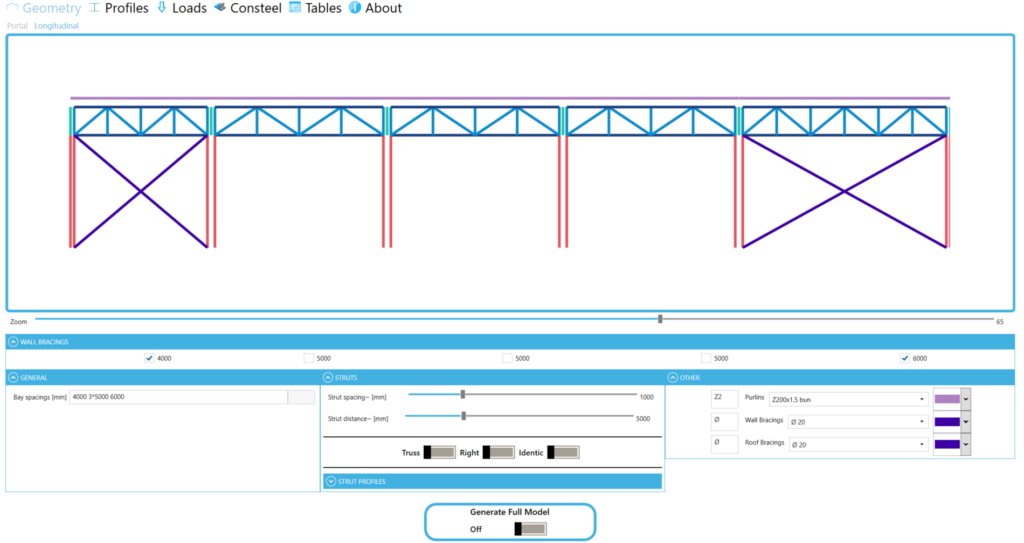
As a potential step, there is a posibility to expand the cross-section library, with typical cold-formed sections which can be manufactured by our customer. Then, as an essential step, all the load parameters have to be defined to obtain the desired ready-to-run Consteel model with all the mechanical objects, supports, loads etc.

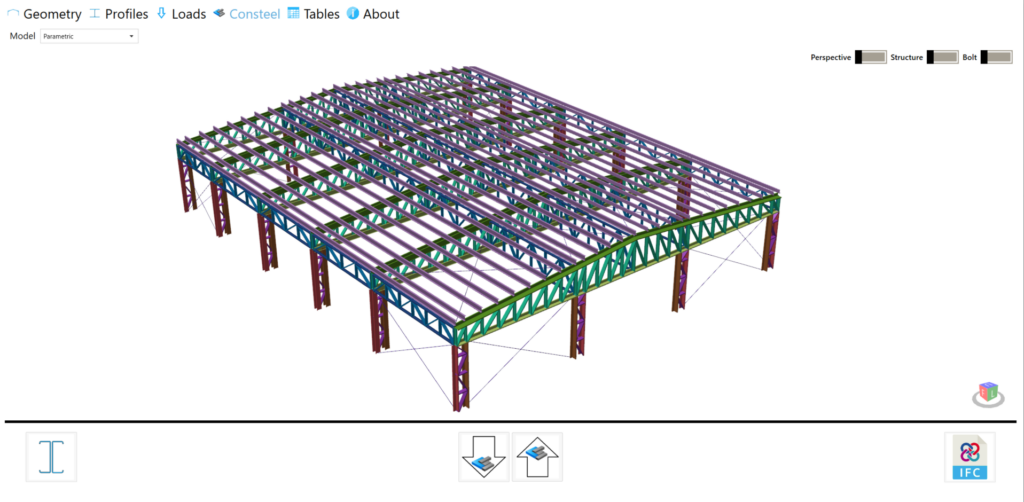
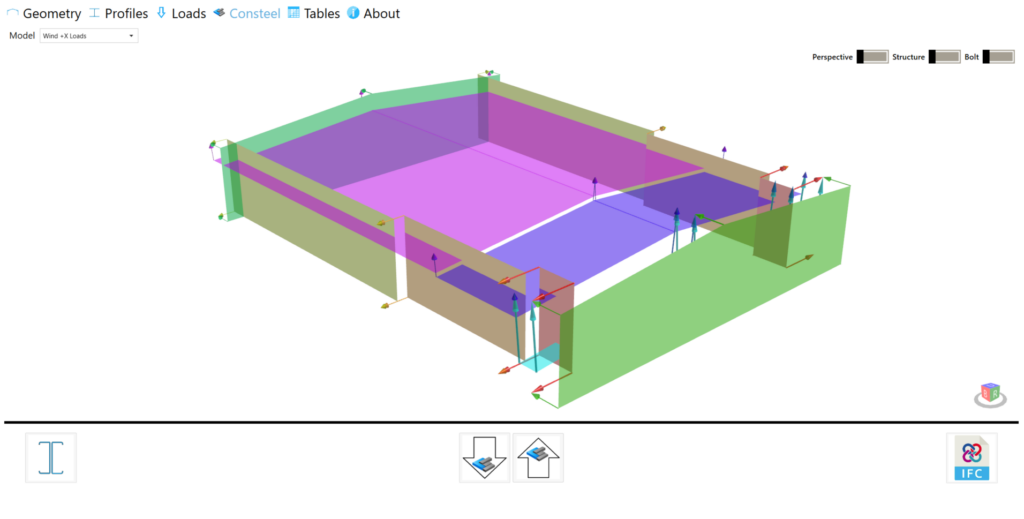
Following the initial successful collaboration, the second version of the tool, developed this year, includes the capability to retrieve available analysis and design results from Consteel. This enhancement allows the tool to prepare data sheets that include material lists for both beams and bolts, as well as internal forces, thereby facilitating the joint design process.
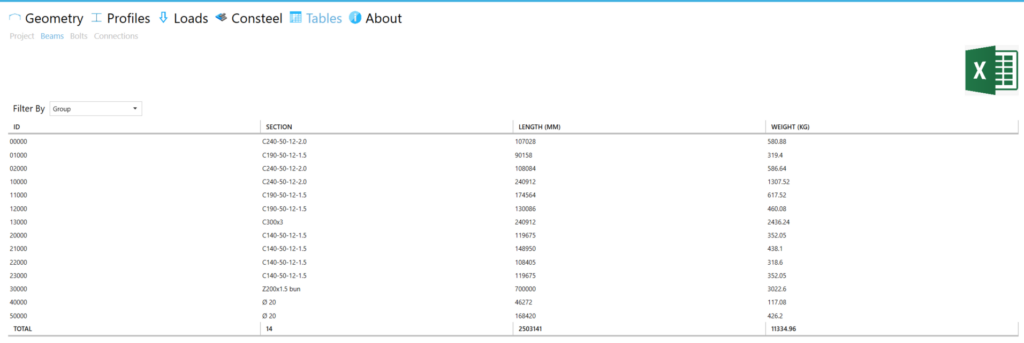
All the tables can later be exported to Excel sheets, while the structure itself can be exported to an IFC model. These functionalities were developed using a range of exceptional third-party plugins, with Pangolin being the primary tool for creating the actual structural model. Additionally, HumanUI was employed to create a smooth user interface that can be effectively utilized even without specific Grasshopper knowledge.
We believe this project serves as a prime example of harnessing not only Pangolin’s inherent potential but also a wide range of open-source applications within the Rhino/Grasshopper community. However, achieving such successful outcome requires an investment of mainly time to delve into computational design. Even with just one dedicated individual, remarkable results can be achieved, thereby expanding the toolbox of an entire team. Consequently, we eagerly anticipate the emergence of more similar projects in the modular, product-based segment of the construction industry.
The ordinary practice of structural design is based on the use of many empirically introduced safety factors and statistical approaches, considering / applying different standards. As a result, the geometrical model of the buildings and the loads acting on them can often differ significantly from reality because of these simplifications, especially if the geometry of the structure is freeform, which is practically impossible to accurately model and analyse with standard tools.
Detaching from reality can be a legitimate concern for a structural designer which amplifies when it comes to wind load evaluation. Thoughtfully, but structural engineers must be able to respond to the needs of today’s architecture. This is why computational fluid dynamics (CFD) simulation methods are increasingly appearing as an alternative solution for the challenges of non-conventional geometries between the conservative solutions offered by the standards and the experimental way, using wind tunnel tests. For this purpose OpenFOAM as a CFD engine offers a wide range of solutions. Although, for these type of simulations a proper environment is essential, where one can easily define all the necessary parameters to setup a flexible simulation case. This led us to begin the implementation of these solutions into our platforms based on our research in the topic. This lead to a new functionality, where one can define the simulation parameters conveniently, using OpenFOAM as the engine without a comprehensive knowledge regarding its use.
Design code interpretations in the case of free-form structures
The effect of the wind acting on a structure can be calculated from the average wind speed and the fluctuating wind speed generated by the turbulence around the building. EN-1991-1-4 defines the wind-generated effects as simplified surface pressures for the calculation of wind loads acting on structures, considering the shape of the structure, its location, the roughness of the terrain, etc. Thus, the wind loads can be considered as a quasi-static external pressure equal to the effect of the turbulent wind with maximum speed. Then the effective surface pressure (or suction), can be determined as the result of the product of the peak pressure (at “z” height above the ground) and the pressure coefficients belonging to the building, according to the design codes, which are covering only a few regular shapers: flat roofs, different pitched roofs, vaulted roofs, domes, etc.
For instance, for the free-form structure below to determine these external pressure coefficients could be really challenging. First of all, due to the relatively low roof slope of the structure, it is difficult to decide whether to consider the roof as a flat roof with curved eaves or as a dome (due that it fits to the surface of a sphere). In the case of a dome, the standard gives 3 characteristic values in a relatively cumbersome way, depending on the eaves height, roof height and diameter of the building. Applying these values to the geometry is highly debatable, especially at the edges.
Similar questions are raised if we try to apply the pressure coefficients on walls which are not regular.
CFD Simulations
Computation Fluid Dynamics is a branch of fluid mechanics that deals with the numerical simulation and analysis of fluid flow and heat transfer phenomena. CFD involves using computer algorithms and numerical methods to solve the governing equations of fluid flow, such as the Navier-Stokes equations, on a discretized domain containing finite element volumes. For these problems OpenFOAM as a toolkit is one of the most suitable.
OpenFOAM contains several applications which can be divide to two main types. Solver-type applications are suitable for solving specific solid or liquid body mechanical problems, while the Utility-type can be used for mesh creation and data management.
To prepare a CFD-based simulation, the following main steps can be identified:
- Preliminary mesh generation processes to create a model suitable both for simulation and load definition
- Define input parameters (wind speed, vp(z) corresponding to the peak value of the wind pressure,wind direction, roughness length z0, boundary conditions, etc.)
- OpenFOAM finite volume mesh generation (define refinements, castellated mesh and snap controls etc.)
- Turbulence model and solver definition (domain initial conditions, run controlling etc.)
The current stage of the development uses only one specific turbulence model, that handles the partial
differential equations of the kinetic energy and the energy distribution rate (k-ε model), with
the solver simpleFoam (SIMPLE = Semi – Implicit Method for Pressure Linked Equations) . In this
scenario, the simulation assumes the following conditions:
- Incompressible, rigid bodies
- Turbulent flow
- No physical time, quasi-static pressure
Our service as a general workflow for wind load evaluation
According to the steps we identified above we began the development of a service which as automatically as possible creates a premesh for load assignment and prepares the necessary data for OpenFOAM, which generates a finite volume mesh ( preprocess stage) and performs a simulation ( dataprocess stage) as shown below. For this, beyond the geometrical and meshing information, suchs as the cell size of the desired loads and the refinement, the user should provide only the wind reference base speed, the direction and the terrain category to define a wind profile according to the civil engineering logic (primarily the Eurocode wind profile corresponding to the peak velocity pressure).
The current development aimed an additional and in the same time the main feature ( postprocess stage) which offers an automated conversion from the resulted pressure values to usable surface loads according to the users preferences. It will be possible to directly assign the simulation results to the premesh, or to apply a zoning logic, similar to the standard.
In conclusion, a serious potential can be observed in the feature, mainly due to its versatility. However, experience shows that although CFD can be used to perform wind load simulations for industrial use, its pertinence is highly dependent on the quality of the input parameters. So a minimal fluid dynamic expertise is still required, but the current state of the development already offers a solution for the structural engineers, in order to create these simulation relatively easily. The service is planned to be implemented in multiple channels using our existing platforms: Consteel (direct desktop use on Consteel models), Steelspace (cloud based use on compatible models) and Grasshopper (use on any models defined in the GH environment for instance with Pangolin) to make it available for as many engineers using different tools as possible.
A new driver is available on our website at Downloads for the USB dongles.
A new driver is available on our website at Downloads for the USB dongles. It is compatible with the latest updates of Windows 10 and 11 too. Please download and install it to ensure flawless operation of your dongle! Only users who use Consteel with an USB dongle protection will need this driver.
How to download the new driver?
Log in to your account on our website and click on the USB driver download icon to download the driver. Then you just need to install it to your computer.
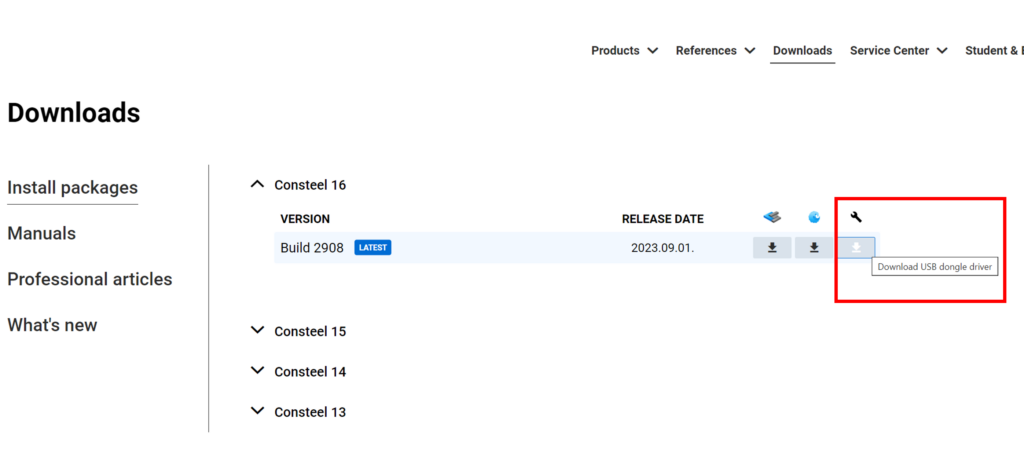
Discover an in-depth case study detailing the expansion of a Turda, Romania plasterboard factory, which shows how the expansion led to the construction of nine new structures. This project, which uses a central parametric model, won third place in this year’s The Steel Lion Award 2023 competiton, thanks to its innovative use of Consteel software for steel structural design and Pangolin, the Rhino-Grasshopper plugin for Consteel.
1. Project Info
The aim of the project is to expand an existing plasterboard factory in Turda, Romania, resulting in the creation of 9 new structures.
These buildings serve various purposes, from raw material processing to waste storage. The building that monitors and serves the manufacturing process is called the „mill,“ constructed from a multi-storey rigid steel frame structure. The maximum frame span is 8 meters, and the total height of the 7-story structure is 28 meters.
2. Central parametric model
While the geometry of the structure is based on classic shapes that may not necessarily require parametric design methods, our goal was to parameterize and create a central BIM model to keep all data in one place during the project’s design process. This data includes 3D models of the technological equipment, technical data sheets, and plans related to them, along with permanent and live loads, all revisions, architectural plans, and more. Given the data provided, we constructed the geometry, defined the loads, and other relevant information. The resulting structure was a complete wireframe model, and its global static analysis was performed using Consteel.
In this way, the centralized model controlled the entire design process from Rhino-Grasshopper interfaces (top-left corner). From here, the complete load evaluation process was coordinated (bottom-left), the construction of the structural model (top-center), the generation of models required for joint calculations (bottom-right) based on the results of the structural analysis (top-right), and ultimately, the whole detail design (bottom-center).
3. Analysis in Consteel
The primary challenge in the design was harmonizing the technology with the structure. Essentially, the design of the technological equipment occurred in parallel with the design of the structure, and the structure had a subordinate role throughout the whole process, necessitating flexibility to adapt to any modifications from the technology side. Within Consteel, we continuously optimized the structure, and utilizing Pangolin’s bidirectional functionality it allowed us to update our centralized model almost instantly. This ensured that the current state was always available, enabling concurrent detailing of the building. Another challenge was that the building was connected to a precast concrete production building. For the affected facades, the ordinary bracing system couldn’t be applied on the first three levels, significantly affecting the structure’s global behavior under horizontal loads. Therefore, it was crucial to consider all structural elements within a global model, in this case, together with the trusses providing the necessary horizontal rigidity.
4. Joint Filtering
Following the main structural analysis, we performed joint analysis using the Grasshopper-IdeaStatica compatibility. This allowed us to filter out type joints (e.g., column bases, column-to-beam connections) from the Consteel model, which were then dimensioned for the internal forces collected automatically. These forces, while considering all possible positions for the selected type joints, represented the maximum concurrent and the absolute maximum values. Using predefined Tekla macros, we distributed the dimensioned connections to all positions with the help of Grasshopper. This method enabled the scattering of 2074 joints on the strut beams with a single click. Using this approach, we distributed over 3800 Tekla macros under Grasshopper control.
5. Conclusions
The design process consisted of two main phases. During the conceptual design phase, which served as the basis for the final authorization plans, we began writing scripts based on a parametric central model. We handled this as an internal development, which could also serve as a starting point for similar projects in the future. Thus, by the time we were creating final detailed plans in the second phase, we had a highly flexible tool at our disposal, providing data for structural checks, global and joint dimensioning, detailing, and ultimately for drawings. This workflow proved to be extremely efficient, requiring only one project lead structural engineer and one engineer responsible for script development and usage throughout the roughly two-year design process from the steel structure perspective. Therefore, when everything was considered final, we were able to involve an additional five engineers, and together, we completed the joint dimensioning, the remaining manual detailing, and the manufacturing design in approximately two months.
This month we have shared 4 new example models regarding fire resistance, cold-formed macro sections, user-defined cross sections, and shear stiffness. Models are available for download from the Knowledge Base.
Perform structural analysis at room and elevated temperatures as part of design process for fire resistance
Did you know that you could use Consteel to perform structural analysis at room and elevated temperatures as part of design process for fire resistance?
Include in your model a wide range of cold-formed macro sections
Did you know that you could use Consteel to include in your model a wide range of cold-formed macro sections?
Draw a user-defined cross section and calculate its section properties
Did you know that you could use Consteel to draw a user-defined cross section and calculate its section properties?
Consider the shear stiffness of a steel deck as stabilization for steel members
Did you know that you could use Consteel to consider the shear stiffness of a steel deck as stabilization for steel members?
To see what else the Consteel software can do, check out the features.
We assess how our partners use the software in their daily works and want to provide support to spend even less time on modeling. This requires your feedback. If you want to take part in shaping Consteel, fill out our 10-20 minutes questionnaire and be part of our updates.
We would like to better understand how our users use Consteel during modeling and their thoughts about the software’s graphical interface. Your answers will help us to make the development of Consteel better and understand your experience.
The survey should only take 10-20 minutes and available in the following languages: English, German, Spanish, Polish, Greek, Romanian, Hungarian. Filling the survey is voluntary and anonymous.
The survey is closed thank you for your time.
Mit der neuen Version Consteel 15 kommen einige neue Featuresund Änderungen, die Ihre Arbeit mit der Software beeinflussen.
Consteel Joint ceases steht nicht mehr als unabhängige Software zur Verfügung
Ab sofort werden wir für Consteel Joint keine separaten Lizenzen mehr anbieten. Die komplette Funktionalität der Anschlusssoftwae wird weiterhin in der Vollversion von Consteel und in den Startprodukten zur Verfügung stehen. Die die aktuellen Nutzer von Consteel Joint mit aktivem W&U-Vertrag bieten wir eine spezielle Lizenz for continued software use.
Einführung neuer Abonnements
Neben der Einführung der neuen Version werden nunmehr zuätzliche Online-Dienste angeboten, die aber mit den bisherigen Lizenzpreisen nicht abgedeckt werden können.Daher haben wir die neuen Abonnementmodelle entwickelt, die gestaffelten Zugang zu den Online-Diensten, der ConSteel Anwender-Mitgliedschaft und verschiedene Softwarezugriffsarten bieten
Dies wird voraussichtlich zu Beginn des Jahres 2022 erfolgen und wir werden Sie bald mit neuen Infos versorgen. Bis dain können Sie bereits auf der Seite Angebote und Plans mehr erfahren.
Online Softwareschutz
Consteel 15 wird dem Softwareschutz mit Dongle nun auch einen Online-Softwareschutz, der mit den neuen Abonnement-Modellen eingeführt wird. Aktuelle Nutzer mit dem USB-Dongle werden eine Option f^ür den Wechsel zum Online-Schutz erhalten, aber bis dahin verwenden Sie noch den USB-Dongle.
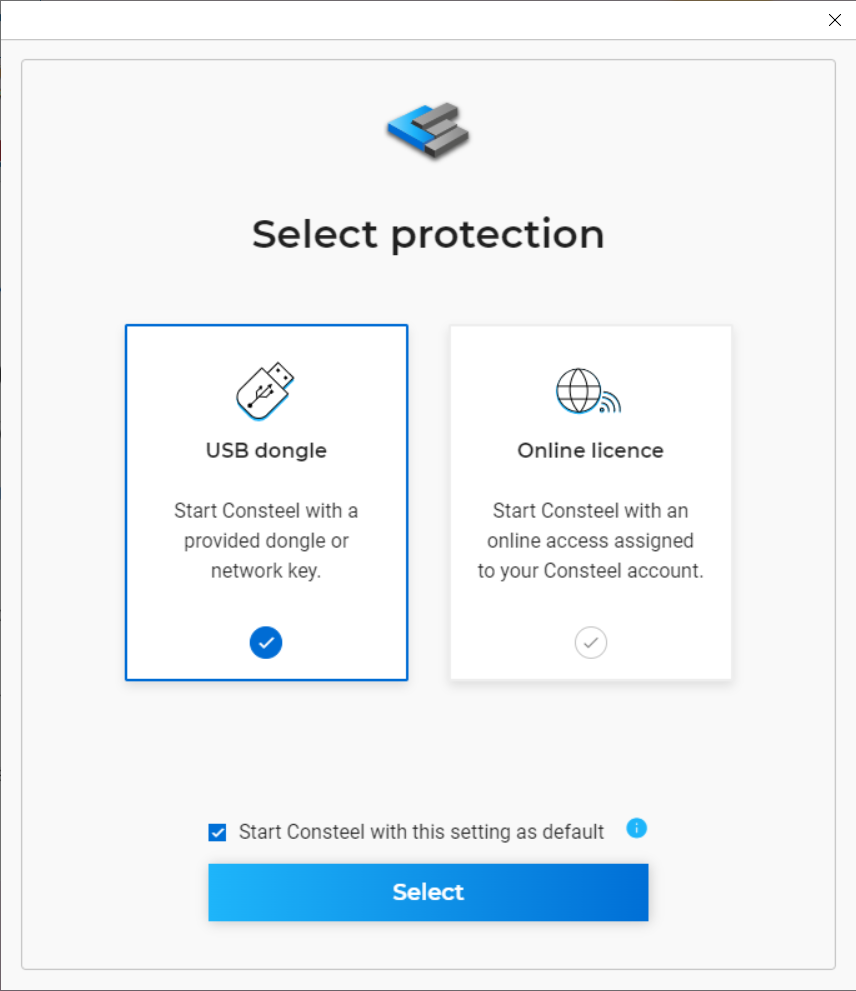
Zugang zu Online-Diensten
Alle ConSteel 15 Anwender können Sie nun als Online-Service z.B. unsere Cloud benutzen, um Strukturmodelle und deren Berechnungsergebnisse dort zu speichern und mit anderen Nutzern zu teilen oder Descript-Codes aus der Skript-Bibliothek. Bis zur Einführung der neuen Abonnement-Modelle Anfang 2022 erhalten zunächst alle Anwender mit gültigem Softwarezugriff diese Dienstleistungen mit dem „Pro“-Level der ConSteel Benutzermitgliedschaft diesen Service kostenlos.
Unsere Anwender mit USB-Dongle Softwareschutz loggen sich mit Ihrer Berechtigung auf unserer Webseite ein. Während der Anwendung der ConSteel Software kann dies aus dem Projekt-Center durch Nutzung des Schalters „Öffnen aus der Cloud“ geschehen, oder beim Speichern mit der Option „Cloud“ bei „File/Sichern als“ oder via Descript-Interface.
Teil 2 – Erweiterte Leistungen
Ziel der erweiterten Leistungen
Unsere Dienstleistungen enden nicht mit der Entwicklung guter und leistungsfähiger Software. Dies gilt aus zwei Gründen besonders für unsere Anwendersoftware zur Tragwerksplanung:
- das Produkt umfasst einen umfangreichen Leistungsbereich und dient dem komplexen Workflow des Tragwerksplaners von der Modellerstellung mit möglichst realistischen mechanischen Simulationen (Lagerungen, Anschlüsse, Exzenrizitäten, Einwirkungen, etc.) bis zur Strukturberechnung und dokumentierten normengerechten Tragfähigkeits- und Gebrauchstauglichkeitsnachweisen;
- eine unsachgemäße Anwendung dieser komplexen Tools kann zu unsicheren Ergebnissen mit ernsthaften Konsequenzen führen, die dann allgemein dem Anwender zuzurechen sind.
Aus der Sicht des Softwareanwenders liegt das Hauptaugenmerk für zusätzlichen Service auf dem Wunsch, die Arbeit mit der Software sicher und effizient zu erledigen. Diese beiden Ansprüche können durchaus Konfliktpotential besitzen und daher ist dazu ein umfangreiches und solides Ingenieurwissen notwendig. Dies bezieht sich nicht nur auf allgemeine strukturmechanische Kenntisse und normengerechte Nachweismethoden sondern eben auch auf die software-spezifischen Lösungen, die typischerweise nicht selbstverständlich sind und auch über die normativen Regelungen (weit) hinausgehen können.
Lernen und das saubere Anwenden von Berechnungs- und Nachweissoftware für Tragwerke verlangt vom Anwender einen beträchtigen Zeitaufwand und auch vom Softwareersteller/-vertreiber einen erheblichen Zusatzaufwand. Trotzdem ist für beide Seiten ein Investment in die Zusatzleistungen sinnvoll, dass sich besondern für die Anwender mit effektiverer und schnellerer Projektabwicklung bezahlt macht. Andererseits führt das intensivere und längere Erlernen (je mehr man Zeit und Energie investiert desto professioneller arbeitet man mit spezifischer Software) zu verstärktem Engagement und vertiefter Identifikation des Anwenders, was ein primäres Ziel des Softwareentwicklers ist.
Im Folgenden zeigen wir Ihnen, wie wir diese zusätzlichen Angeote implementieren und manageen wollen und wie wir über das Benutzer-Engagement denken.

Consteel Gemeinschaft
Wir bei ConSteel glauben fest an die Power der Entwickler- und Nutzergemeinschaft, was in unserem Fall – Softwareentwickler und -anwender – bedeutet, gemeinsame Werte und Ziele zu akzeptieren und unsere Talente und Kenntnisse zu teilen, um mehr denn je gemeinsam erfolgreicher zu sein.
Dementsprechend sollen unsere Kontake zu den Kunden keine Einbahnstraße sondern eine gegenseitige engagierte Beziehung sein, in der wir unsere besten Kenntnisse in Form moderner und zukunftsorientierter Software und zusätzlichen ergänzenden Dienstleistungen bieten und bereit sind, auf Fragen und Bedürfnisse aus der praktischen Expertise unserer Kunden zu reagieren. Dies stellt weit mehr als ein einfaches Software-Abonnement dar, es ist bereits eine Mitgliederorganization.
Gemäß Wikipedia hat eine Mitgliederorganization “… typischerweise einen speziellen Grund, die Menschen bezüglich eines speziellen Berufs, einer Industrie, einer Aktivität, eines Interesses, einer Mission oder einer geografischen Lage verbindet. Dies kann in einfacher Weise zu Interaktion und Zusammenarbeit ermutigen oder ermöglichen, aber oft geht es auch nur darum, den Zweck selbst zu fördern und zu verbessern“ .
And genau das streben wir an:
“Wir möchten eine neue Generation der Benutzergemeinschaft unterstützen, in der die leitenden Regeln Zusammenarbeit und Wissensteilung darstellen. Unser Traum ist Bedürfnisse/Anforderungen und Lösungen, Benutzer und Enwickler, Modelle und Berechnungenn aus der kompletten Welt der Tragwerksplaner zusammenzuführen, um wirklich effiziente Projektentwicklungen mit der Power Ingenieurgemeinschaft zu verwirklichen.”
Deshalb ändern wir unser früheres System für Support, Wartung und Updates sowie Upgrades und fassen unsere ergänzenden Leistungen zu einem mehrstufigen ConSteel Nutzermitgliedsschaft zusammen. In engen Zusammenhang mit dem neuen Lizenzierungssystem, bei dem wir den Zugang (keine permanente Lizenz ohne ein Abonnement) zur aktuellen Softwareversion nur Benutzern mit laufender Softwarelizenz gewähren, wollen wir eine engagierte Nutzergemeinschaft der oben beschriebenen Art bilden, dennn wir denken, dass dies wirkungsvoller als ein bloßes Abonnement ist.
Das Nutzerengagement hat verschiedene Stufen vom passiven eindirektionalen Informationfluss, von einer brückenbildenden reaktiven Beteiligung bis zu einem voll integrativen und kooperativen Engagement. Letzteres ist der von uns bevorzugte transformationelle und „game-changing way“ der Zusammenarbeit und wir wünchen von unseren Anwendern Vorwärtsschritte vom niedrigsten Level zu diesem innerhalb der ConSteel-Nutzergemeinschaft. Wir haben eine Bedienerumgebung und Tools für die erweiterten Leistungen erstelt, die im Folgenden erläutert werden.
Angebote für Leistungen
Je nach Benutzerinteresse und -engagement bieten wir folgende Leistungen:
- Softwarequalität, Updates
- Flexible Lizenzierung
- Qualitätslevel und -tiefe des Supports
- Erweiterte Leistungen:
- klassische Leistungen:
- Lernmaterial
- Schulung
- Events (Benutzertage, Wettbewerbe, etc.)
- Feedback-Kanäle (Überprüfungen, schnelles Antwortystem, etc.)
- erweiteter ConSteel-Service
- Cloud-Dienste
- Scripting
- klassische Leistungen:
Die meisten Listenpunkte bedürfen keiner weiteren Erläuterung, aber einige Schlüsselfeatures zur Gemeinschaftsbildung sollen hier diskutiert werden. Zunächst soll die Verfügbarkeit der Dienstleistungen und anschließend Hintergrund, Ziele und einige Inhalte der in diesem Jahr neu eingeführten speziellen Dienste Cloud und Scripting erläutert werden.
Zu erwähnen ist auch unser volles Engagement zur Entwicklung weiterer Dienstleistungen nicht nur durch ständige Erweiterung der Inhalte sondern auch mittels der Wege und Informationskanäle zur Verbesserung des Nutzerengagements.
Exklusivität der Dienste
Wichtig für eine gute Mitgliedergemeinschaft und die Organisation der verfügbaren werthaltigen Dienste ist die Exklusivität für die Mitglieder. Es ist ein bekannter Fakt, dass Menschen viel mehr das schätzen, wofür sie bezahlen.
Kunden tendieren leicht dazu, kostenlose Serviceaktivitäten oder erhaltene Leistungen aufzuschieben, zu verdrängen oder zu vergessen– ein typisches Beispiele sind kostenlose Webinare, wobei dies aber nur ein Bruchteil der Teilnehmer betrifft. Sie schätzen mehr den Wert – und dementsprechend sind sie dann aktiver – von bezahlten Diensten, was ein größeres Engagement Teilnahme an der Mitgliedschaft zur Folge hat. Die Nutzer müssen auch anerkennen, das Produktion und Promotion dieser zusätzlichen Dienstleistungen Kosten darstellen, die naturgemäß durch unsere besten Experten entstehen und daher sind diese Dienste für unsere Kunden kostenpflichtig.
Unser vorrangiges Ziel ist die Verbesserung des Mitgliederengagements und daher reservieren wir die wertvollsten Dienste exklusiv für die Teilnehmer unserer Mitgliedsorganisation und wir werden dies -wie im Augenblick noch- nicht jedermann kostenfrei zur Verfügung stellen. Einige der Dienste– hauptsächlich die klassischen Lehrmaterialien – werden in unserem neuen Servicecenter zur Verfügung stehen, aber verschiedene andere Leistungen sind in Planung zur Ergänzung der Softwarefeatures.

Cloud-Dienste
Mit unseren brandneuen Cloud-Diensten wollen wir unsere Nutzer motivieren, moderne Kommunikations- und Speichertechniken zu nutzen. Wir sehen bei den Cloud-Diensten ein großes Potential und dementsprechend investieren wir mehr und mehr, plazieren dort exklusiv spezielle Software-Funktionalitäten , welche unserer Ansicht nach dort effektiver als auf dem Desktop funktionieren.
Andererseits denken (und hoffen) wir, dass die Nutzung der Cloud die Kultur des Informationsaustauschs und des Feedbacks bei der Tragwerksplanung fördert, was in dieser Branche noch selten ist (im Gegenteil zu Softwareentwicklerkommunities, wo dies bereits allgemein der Fall ist). So ist es unser unverhülltes Ziel, dass die von uns angebotenen Cloud-Dienste unseren Nutzern helfen werden, sich in der Nutzergruppe auch mehr zu engagieren.
In der aktuellen ersten Phase bieten wur zunächst einen einfachen Weg zur zum Laden, Speichern und Öffnen kompletter ConSteel-Modelldateien, die sie auch mit Ihren Kollegen entweder in der Cloud oder sogar mit der ConSteel-Software teilen können. Die Anwender erhalten praktischerweise Zugriff zu den in der Cloud gespeicherten Dateien von Ihren Bürocomputern, vom Laptop zu Hause oder von irgendwo und jedem Gerät mit Online-geschützter ConSteel-Software. Derart geteilte Modelle können die Basis eines realen kollaborativen Workflows in einem Tragwerksprojekt innerhalb eines Ingenieurbüros oder eines Lehrinstitutes sein.

Scripting Dienste
Scripting-Techniken sind eine moderne und effiziente Mehode zur Kontrolle und Verwaltung von Modellerstellung, -veränderung und -berechnungen. Letztes Jahr stellten wir unser Grasshopper-Plugin, genannt „Pangolin“, vor, womit akluelle und -hoffentlich auch viele zukünftige- Grasshopper-Anwender ein komplettes, parametrisches ConSteel-Modell erstellen, berechnen und nachweisen können. Schon einige Jahre früher haben wir eine eigene in die ConSteel-Software integrierte baubezogene Script-Sprache als interne Programmierumgebung csPI implementiert. Zielgruppe dieser Sprache sind Tragwerksplaner ohne Porgrammierkenntnisse und dies nennen wir zukünftig Descript.
Für die praktische Anwendung wurde Descript als Programmiersprache entwickelt, die der Logik, Syntax und internen Struktur der ConSteel Objekte mit ihren Attributen und Operationen folgt. Die Programmumgebung ist innerhalb der ConSteel-Benutzeroberfläche platziert, sodass keine externe Programmierumgebung notwendig ist. Die Benutzerumgebung wurde für mehr Anwenderfreundlichkeit und noch einfachere Benutzung komplett überholt und mit verschiedenen Zusatzdiensten ausgestattet.
Die Programmiertätigkeit mit Descript ist jetzt mit einem ausführlichen Handbuch und verschiedenen Code-Beispielen begleitet. In der neuen Script-Bibliothek werden zukünftig kontinuierlich Beispiele hinzugefügt, die nützliche Funktionalitäten mit unterschiedlicher Komplexität haben. Die wichtigste Neuerung ist das Interface MyDescript, wo der gesamte Programmcode als Bibliothek zum Zugriff bereit steht, ausgeführt, gespeichert und auch modifiziert werden kann, wenn das Mitgliedslevel dazu ausreicht.
Diese Dienste wurden insbesondere zum Start der Arbeit mit dem Scripting ins Leben gerufen. Zukünftig planen wir hier auch die Leistungsfähigkeit der Mitgliedsschaft auszuschöpfen, damit alle Teilnehmer die Descript-Programmiercodes gegenseitig teilen, kommentieren, bewerten und verbessern können.

